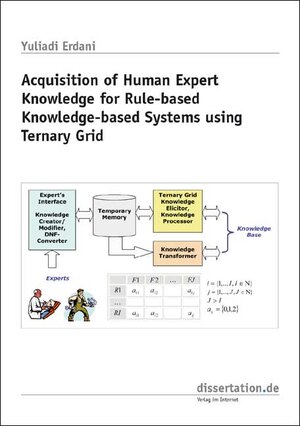
×
![Buchcover ISBN 9783898250009]()
Acquisition of Human Expert Knowledge for Rule-based Knowledge-based Systems using Ternary Grid
von Yuliadi ErdaniKnowledge acquisition is a task in Artificial Intelligence (AI) concerned with eliciting and representing knowledge of human experts and the most important element in the development of expert system. It deals with extracting knowledge from sources of expertise and transferring it to a knowledge base. Knowledge acquisition is still a major and critical phase in the development of expert systems and the most difficult and error-prone task that knowledge engineer does while building a knowledge-based system or an expert system. It is not an easy task to acquire knowledge from human expert not trained in knowledge engineering. The performance of the knowledge due to the redundant and faulty information is performed by interaction between experts and knowledge engineer during acquisition process.
The need to overcome the knowledge acquisition bottleneck is also recognised beyond the knowledge acquisition community. In order to solve that problem and to achieve that mentioned performance, a rule-based knowledge acquisition system using Ternary Grid is developed.
The Ternary Grid is a model of rule-based knowledge in a grid format where every cell represents the relation between a rule and a fact. The cell of the grid can only allow value “0”, “1” or “2” that is called ternary value. Value “1” represents the condition part of a rule. Value 2 the conclusion part of a rule. Value “0” represents relation less between rule and fact. The Ternary Grid is convenient for processing the knowledge. They may be directly viewed as task domain and production rule structure. The grid has elements as problem-solving domains which can be derived into sub domains or group of rules, rows as rules, columns as facts and values as IF-THEN syntax.
The Ternary Grid knowledge acquisition and representation work in a model domain using concept matrix or set operation. The organisation and logical content of expert knowledge in Ternary Grid can be easily inspected and analysed. Completion and recognition of patterns which consists of “0 or empty”, ”1”, “2”values in the grid are facilitated by the structure and relative compactness of the matrix representation. Representation in the Ternary Grid facilitates optimising and testing for conditions of ambiguity, redundancy, completeness and correctness.
The need to overcome the knowledge acquisition bottleneck is also recognised beyond the knowledge acquisition community. In order to solve that problem and to achieve that mentioned performance, a rule-based knowledge acquisition system using Ternary Grid is developed.
The Ternary Grid is a model of rule-based knowledge in a grid format where every cell represents the relation between a rule and a fact. The cell of the grid can only allow value “0”, “1” or “2” that is called ternary value. Value “1” represents the condition part of a rule. Value 2 the conclusion part of a rule. Value “0” represents relation less between rule and fact. The Ternary Grid is convenient for processing the knowledge. They may be directly viewed as task domain and production rule structure. The grid has elements as problem-solving domains which can be derived into sub domains or group of rules, rows as rules, columns as facts and values as IF-THEN syntax.
The Ternary Grid knowledge acquisition and representation work in a model domain using concept matrix or set operation. The organisation and logical content of expert knowledge in Ternary Grid can be easily inspected and analysed. Completion and recognition of patterns which consists of “0 or empty”, ”1”, “2”values in the grid are facilitated by the structure and relative compactness of the matrix representation. Representation in the Ternary Grid facilitates optimising and testing for conditions of ambiguity, redundancy, completeness and correctness.


